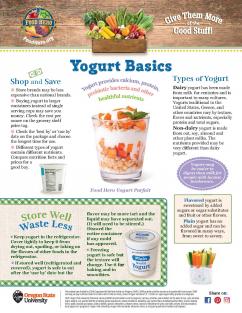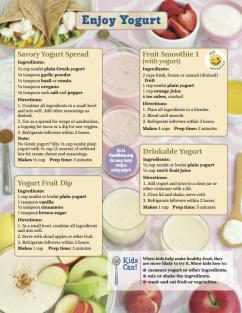Yogurt Basics
Yogurt provides calcium, protein, probiotic bacteria, and other healthful nutrients
Shop and Save
- Store brands may be less expensive than national brands.
- Buying yogurt in larger containers instead of single serving cups may save you money. Check the cost per ounce of the grocery shelf price tag.
- Check the 'best by' or 'use by' date on the package and choose the longest time for use.
- Different types of yogurt contain different nutrients. Compare nutrition facts and prices for a good buy.
Types of Yogurt
Dairy yogurt has been made from milk for centuries and is important to many cultures. Yogurts traditional to the United States, Greece, and other countries vary by texture, flavor, and nutrients, especially protein and total sugars.
Non-dairy yogurt is made from oat, soy, almond, and other plant milks. The nutrients provided may be very different than dairy yogurt.
Yogurt may be easier to digest than milk for people with lactose intolerance.
Flavored yogurt is sweetened by added sugars or sugar substitutes and fruit or other flavors.
Plain yogurt has no added sugar and can be flavored in many ways, from sweet to savory.
Store Well Waste Less
- Keep yogurt in the refrigerator. Cover tightly to keep it from drying out, spoiling, or taking on the flavors of other foods in the refrigerator.
- If stored well (refrigerated and covered), yogurt is safe to eat after the 'use by' date but the flavor may be more tart and the liquid may have separated out (it will need to be stirred). Discard the entire container if any mold has appeared.
- Freezing yogurt is safe, but the texture will change. Use it for baking and in smoothies.
Enjoy Yogurt
Recipes
Savory Yogurt Spread
Yogurt Fruit Dip
Fruit Smoothie 1 (with yogurt)
Drinkable Yogurt
Kids Can!
When kids help make healthy food, they are more likely to try it. Show kids how to:
- measure yogurt or other ingredients.
- mix or shake the ingredients.
- wash and cut fruit or vegetables.




